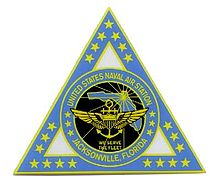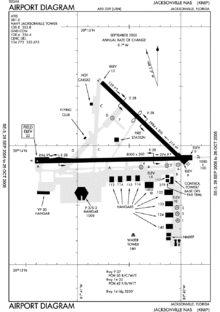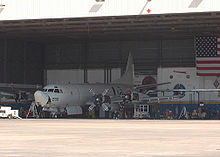- Naval Air Station Jacksonville
-
Coordinates: 30°14′09″N 081°40′50″W / 30.23583°N 81.68056°W
NAS Jacksonville
Towers Field
IATA: NIP – ICAO: KNIP – FAA LID: NIP Summary Airport type Military: Naval Air Station Operator United States Navy Location Jacksonville, Florida Built October 15, 1940 Commander CAPT John C. Scorby Elevation AMSL 22 ft / 7 m Website Runways Direction Length Surface ft m 10/28 8,000 2,438 Asphalt 14/32 5,980 1,823 Asphalt Sources: official site[1] and FAA[2] Naval Air Station Jacksonville or NAS Jacksonville (IATA: NIP, ICAO: KNIP, FAA LID: NIP) is a military airport located four miles (6 km) south of the central business district of Jacksonville. It is one of two naval bases (the other being Naval Station Mayport) located in Duval County, Florida, United States.[2]
Contents
History
During World War I, the area now occupied by NAS Jacksonville...often referred to colloquially as "NAS Jax"...was named Camp Joseph E. Johnston, and was commissioned on October 15, 1917. The United States Army trained quartermasters and the center included more than 600 buildings. The second largest rifle range in the U.S. was constructed there, but the camp was decommissioned on May 16, 1919. The Florida National Guard began using the site in 1928 and it was renamed Camp J. Clifford R. Foster.[3]
The first detail of Marines arrived from Parris Island, South Carolina on June 4, 1940 to secure the 3,250-acre (13 km2) area, setting up a barracks in a former residence on Allegheny Road. On October 15, 1940, Naval Air Station Jacksonville was officially commissioned, and became the first part of the Jacksonville Navy complex that would eventually include NAS Cecil Field and Naval Station Mayport, as well as numerous naval auxiliary air stations and outlying fields in northeast Florida. On the same date, Captain Charles P. Mason, USN, raised his command pennant as the station's first commanding officer.
Prior to the commissioning, on September 7, Commander Jimmy Grant became the first pilot to land on the still unfinished runway in his N3N-3 biplane. More than 10,000 pilots and 11,000 aircrewmen followed their lead to earn their "wings of gold" at the air station during World War II.
Increased training and construction characterized NAS Jacksonville’s response to America’s entry into World War II. Three runways over 6,000 feet (1,800 m) long were operating, as were seaplane runways in the St. Johns River and seaplane ramps leading from the water. Overhaul and Repair (O&R) facilities were built to rework the station's planes, a facility that in ensuing years would be renamed Naval Air Rework Facility Jacksonville (NARF Jax), Naval Aviation Depot Jacksonville (NADEP Jax) and its current name of Fleet Readiness Center Southeast.
More than 700 buildings sprung to life on the base before V-J Day (Victory over Japan), including an 80-acre (320,000 m2) hospital and a prisoner-of-war compound which housed more than 1,500 German prisoners of war. Archbishop (later Cardinal) Francis J. Spellman dedicated the Catholic Chapel (St. Edward’s) at its Birmingham Avenue location on January 17, 1943. The chapel and other buildings constructed during the war years, intended for a life of only 20 years, are still in use.
During the late 1940’s, the jet age was dawning and in 1948 the Navy’s first jet carrier air groups and squadrons came to NAS Jacksonville. By April 1949, NAS Jacksonville was the East Coast's aircraft capital, with more naval aircraft stationed here than at any other naval base from Nova Scotia to the Caribbean – 60 percent of the Fleet's air striking force in the Atlantic area from pole to pole.
NAS Jacksonville continued growing throughout the late 1940s. Fleet Air Wing Eleven made its move to the base, bringing with it Patrol Squadron THREE (VP-3) from NAS Coco Solo, Panama and Patrol Squadron FIVE (VP-5) from NAS San Juan, Puerto Rico. The now famous U.S. Naval Flight Demonstration Squadron, the Blue Angels, who had called NAS Jacksonville home but later moved to NAS Corpus Christi in the late 1940’s, performed a last air show at the station on April 29, 1950, before forming the nucleus of an operational fighter squadron, VF-191 (Satan’s Kittens), which was assigned to combat in Korea. The "Blues" would not return to the station for more than two years. In the early 1950s, Naval Air Technical Training Center (NATTC) Jacksonville was also reactivated and included nine different schools.
In the mid-1950s, an air traffic control center for joint use by the Navy, Air Force, and Civil Aeronautics Administration was approved and completed at a cost of $325,000. Major changes also occurred as parking ramps were added shore-based aircraft hangars and a 1,231-foot (375 m)-long taxiway was built.
By the mid-1950s, with the station's continuing growth, the Navy was having a tremendous impact on the economic growth in the Jacksonville and Duval County area. The station had over 11,000 military personnel assigned, along with 5,000 civilians and an annual payroll of more than $35 million.
In March 1959, Marine Attack Squadron ONE FOUR TWO (VMA-142) of the Marine Corps Reserve relocated to NAS Jacksonville from the closing MCAS Miami, along with the associated Marine Air Reserve Training Detachment (MARTD). VMA-142 would remain at NAS Jax until its relocation to nearby NAS Cecil Field in 1978.
In 1970, a major reorganization of the Naval Reserve resulted in three separate Naval Air Reserve flying squadrons, identical to their active duty Regular Navy counterparts, being activated at NAS Jacksonville. These squadrons consisted of Attack Squadron TWO ZERO THREE (VA-203), Patrol Squadron SIXTY-TWO (VP-62) and Fleet Logistics Support Squadron FIFTY-EIGHT (VR-58). VA-203 would later relocate to NAS Cecil Field in 1977, with the remaining reserve squadrons joined by Helicopter Antisubmarine Squadron SEVENTY-FIVE (HS-75) in 1985 following its relocation from NAS Willow Grove, Pennsylvania.
In 1973, with the assignment of Helicopter Antisubmarine Wing One, the station’s primary mission became antisubmarine warfare. Accompanying the wing were five helicopter squadrons which are still based here today. With the new wings and squadrons, opportunities grew for both sea duty and shore duty assignment to NAS Jacksonville. The station's popularity grew and it became one of the most requested duty station for sailors and officers in Naval Aviation throughout the Navy.
A piece of history and Navy and Marine Corps tradition was lost in 1986 when the last unit of Marines left NAS Jacksonville. Marine Barracks Jacksonville had been one of the first groups to arrive at the base in 1940, but left due to mission realignments and a reduction in Marines authorized for Marine Corps Security Force duties at U.S. Naval installations.
USAF Radar Station
The United States Air Force Air Defense Command established a Phase III Mobile Radar station at NAS Jacksonville in 1 July 1957 with the 679th Aircraft Warning and Control Squadron operating AN/FPS-3, AN/FPS-8, and AN/MPS-14 radars as part of the ADC radar network. It was designated as ADC site M-114. In 1962 AN/FPS-66 radar and a pair of AN/FPS-6 heightfinder radars were added.
During 1962 M-114 joined the Semi Automatic Ground Environment (SAGE) system, feeding data to DC-09 at Gunter AFB, Alabama. After joining, the squadron was re-designated as the 679th Radar Squadron (SAGE) on 1 October 1962. On 31 July 1963, the site was redesignated as NORAD ID Z-114.
In addition to the site at NAS Jacksonville, the 679th operated several "Gap Filler" remote sites to extend its radar coverage:
- Bunnell, FL (M-114A): 29°21′16″N 081°18′42″W / 29.35444°N 81.31167°W
- Blythe Island, GA (M-114B): 31°09′43″N 081°33′44″W / 31.16194°N 81.56222°W
In 1963 M-114 became a joint-use facility with the Federal Aviation Administration (FAA). It performed routine general radar surveillance until 30 September 1981 when the site was inactivated.[4][5]
Current operations
Force reductions in the 1990s and early 2000s eliminated several P-3C squadrons (VP-24, VP-49, VP-56) and SH-60F/HH-60H squadrons (HS-1, HS-9, HS-75) at NAS Jacksonville, while the BRAC-directed closure of nearby NAS Cecil Field resulted in the relocation of Sea Control Wing ONE and its multiple Sea Control Squadrons (VS-22, VS-24, VS-29, VS-30, VS-31) operating the S-3 Viking until that aircraft's retirement from the active Fleet in 2008.
Today, 23,000 civilian and active-duty personnel are employed on the base. The installation is considered to be one of the hubs for naval activity in the U.S. South. Other U.S. Navy Bases in the area include Naval Station Mayport, Naval Submarine Base Kings Bay in Camden County, Georgia and Naval Outlying Landing Field Whitehouse.
With the BRAC-directed closure of NAS Brunswick, Maine by mid-2011, Patrol Squadron EIGHT (VP-8), Patrol Squadron TEN (VP-10), Patrol Squadron TWENTY-SIX (VP-26), Patrol Squadron Special Projects Unit ONE (VPU-1) and Fleet Logistics Support Squadron SIXTY-TWO (VR-62) began relocating to NAS Jacksonville in 2007 with their P-3C and C-130T aircraft, with all of these squadrons in place at NAS Jacksonville by late 2010.
In addition to the many operational active and reserve squadrons aboard, NAS Jacksonville is also home to
Patrol Squadron THIRTY (VP-30), the Navy's largest aviation squadron and the only P-3 Orion Fleet Replacement Squadron that prepares and trains U.S. and NATO/Allied pilots, air crew and maintenance personnel for further operational assignments in the P-3C Orion and EP-3E Aries in the U.S. Navy, and P-3B, P-3C and similar variants in various NATO and Allied navies and air forces. VP-30 will also be the first squadron to operate the U.S. Navy's new P-8 Poseidon aircraft, training flight crews and maintainers as all U.S. Navy patrol squadrons eventually transition to this new platform.NAS Jacksonville is also an Aviation Maintenance training facility for several aviation rates, facilitated by Center for Naval Aviation Technical Training Unit Jacksonville.
Support facilities include an additional outlying field (OLF Whitehouse) for pilot training, a maintenance depot employing more than 150 different trade skills capable of performing maintenance as basic as changing a tire to intricate micro-electronics or total engine disassembly, a Naval Hospital, a Fleet Industrial Supply Center, a Navy Family Service Center, a DeCA commissary, Navy Exchange, and recreational facilities for both single sailors and families of the Active, Reserve and Retired military communities.
Tenant Commands
Aviation Units
- Commander, Patrol and Reconnaissance Wing 11
- Patrol Squadron 5
- Patrol Squadron 8
- Patrol Squadron 10
- Patrol Squadron 16
- Patrol Squadron 26
- Patrol Squadron 30
- Patrol Squadron 45
- Patrol Squadron 62 (Navy Reserve)
- Patrol Squadron Special Projects Unit 1
- Commander, Helicopter Sea Combat Wing, U.S. Atlantic Fleet, Detachment Jacksonville
- Helicopter Antisubmarine Squadron 3
- Helicopter Antisubmarine Squadron 5
- Helicopter Antisubmarine Squadron 7
- Helicopter Antisubmarine Squadron 11
- Helicopter Antisubmarine Squadron 15
- Commander, Fleet Logistics Support Wing
Shore Commands
- Commander, Naval Region Southeast
- Commander, Naval Reserve Readiness Command Region Eight
- Fleet Area Control & Surveillance Facility Jacksonville
- Fleet Readiness Center Southeast (formerly Naval Aviation Depot (NADEP) Jacksonville)
- Naval Hospital Jacksonville
- Naval Branch Clinic Jacksonville
- Naval Branch Dental Clinic Jacksonville
- Fleet & Industrial Supply Center Jacksonville
- Naval Air Reserve / Navy Operational Support Center
- Naval Aviation Forecast Component Jacksonville
- Naval Computer & Telecommunications Station
- Naval Mobile Construction Battalion 14
- Naval Supply Center Jacksonville
- Center for Naval Aviation Technical Training Unit Jacksonville (formerly NAMTRAGRUDET Jacksonville)
- Naval Exchange Commande (NEXCOM) Southeast District
- Naval Facilities and Engineering Command (NAVFAC) Southeast Headquarters
- NAVFAC Southeast Public Works Department Jacksonville
- Transient Personnel Unit
Other Agencies
- Defense Logistics Agency
- DRMO Jacksonville
- U.S. Customs and Border Protection
References
- ^ Naval Air Station Jacksonville (official site)
- ^ a b FAA Airport Master Record for NIP (Form 5010 PDF), effective 2007-10-25
- ^ "Camp Joseph E. Johnston (Jacksonville, Fla.) Collection" University of North Florida, Carpenter Library
- ^ A Handbook of Aerospace Defense Organization 1946 - 1980, by Lloyd H. Cornett and Mildred W. Johnson, Office of History, Aerospace Defense Center, Peterson Air Force Base, Colorado
- ^ Winkler, David F. (1997), Searching the skies: the legacy of the United States Cold War defense radar program. Prepared for United States Air Force Headquarters Air Combat Command.
- Naval Air Station Jacksonville GlobalSecurity.org. retrieved 2006-10-26
External links
- First detail of Marines reaches city. Florida Times Union, June 5, 1940.
- FAA Airport Diagram (PDF), effective 20 October 2011
- Resources for this U.S. military airport:
- AirNav airport information for KNIP
- ASN accident history for NIP
- NOAA/NWS latest weather observations
- SkyVector aeronautical chart for KNIP
- Jax Air News is the newspaper serving NAS Jax and the Jax Air News website contains current issues and the Florida Digital Newspaper Library contains the Jax Air News historical archives available freely and openly available with full searchable text
Navy  Air StationStationOutlying FieldSupport ActivityOther
Air StationStationOutlying FieldSupport ActivityOtherAir Force  FieldCape Canaveral • Cudjoe KeyRange
FieldCape Canaveral • Cudjoe KeyRangeNational Guard 
Coast Guard  GroupKey West • Mayport • Miami • St. PetersburgDistrictSeventh
GroupKey West • Mayport • Miami • St. PetersburgDistrictSeventhBases CONUSAdair · Beale · Bong (unbuilt) · Charleston · Davis-Monthan · Dobbins · Dover · Dow · Duluth · England · Ent · Ethan Allen · Fairfax · Fort Lee · Geiger · George · Glasgow · Grand Forks · Grenier · Griffiss · Gunter · Hamilton · Hancock · Homestead · Hurlburt · Imeson · K.I. Sawyer · Kincheloe · Kingsley · Kirtland · Larson · Luke · March · Malmstrom · McCoy · McChord · McClellan · McGhee Tyson · McGuire · Minneapolis-St. Paul · Minot · Mitchel · New Castle · Niagara Falls · Norton · O'Hare · Oklahoma City · Otis · Oxnard · Paine · Perrin · Peterson · Pittsburgh · Pope · Portland · Presque Isle · Richards-Gebaur · Selfridge · Seymour Johnson · Sioux City · Snelling · Stead · Stewart · Suffolk County · Tinker · Travis · Truax · Tyndall · Vandenburg · Webb · Westover · Willow Run · Wright-Patterson · Wurtsmith · Youngstown
OverseasErnest Harmon · Frobisher Bay · Goose Bay · Keflavik · Pepperrell · Thule · Topsham

Stations CONUSAlmaden · Charleston · Clear · Cross City · Benton · Empire · Mill Valley · Montauk · Mount Hebo · North Truro · Point Arena · Rye · Thomasville · Watertown
OverseasAlbrook
Air
Defense
unitsForcesAir
DivisionsSectorsAlbuquerque · Bangor · Boston · Chicago · Detroit · Duluth · Goose · Grand Forks · Great Falls · Iceland · Kansas City · Los Angeles · Minot · Montgomery · New York · Oklahoma City · Phoenix · Portland · Reno · Sault Sainte Marie · San Francisco · Seattle · Sioux City · Spokane · Stewart · Syracuse · Washington
WingsGroups1st · 4th · 10th · 14th · 15th · 23rd · 32nd · 33rd · 50th · 52nd · 53rd · 54th · 56th · 57th · 73rd · 78th · 79th · 81st · 82nd · 84th · 325th · 326th · 327th · 328th · 329th · 337th · 355th · 408th · 412th · 414th · 473rd · 475th · 476th · 478th · 500th · 501st · 502d · 503d · 507th · 514th · 515th · 516th · 517th · 518th · 519th · 520th · 521st · 525th · 527th · 528th · 529th · 530th · 533d · 534th · 564th · 566th · 567th · 568th · 575th · 678th · 701st · 4676th · 4700th · 4721st · 4722d · 4727th · 4728th · 4729th · 4730th · 4731st · 4732d · 4733d · 4734th · 4735th · 4756th
SquadronsAerospace Defense Command Fighter Squadrons · Aircraft Control and Warning Squadrons
Major
weapon
systemsElectronicFightersMissiles1 · 2 · 3 · 4 · 5
ShipsGuardian · Interceptor · Interdictor · Interpreter · Investigator · Locator · Lookout · Outpost · Pickett · Protector · Scanner · Searcher · Skywatcher · Tracer · Watchman · Vigil
Miscellaneous Air Defense Command Emblem Gallery (On Wikimedia Commons) · General Surveillance Radar StationsCategories:- United States Navy bases
- United States naval air stations
- Buildings and structures in Jacksonville, Florida
- Military in Jacksonville, Florida
- Military Superfund sites
- Military facilities in Florida
- Airports in Jacksonville, Florida
- SAGE sites
- Radar stations of the United States Air Force
- Closed facilities of the United States Air Force
Wikimedia Foundation. 2010.




